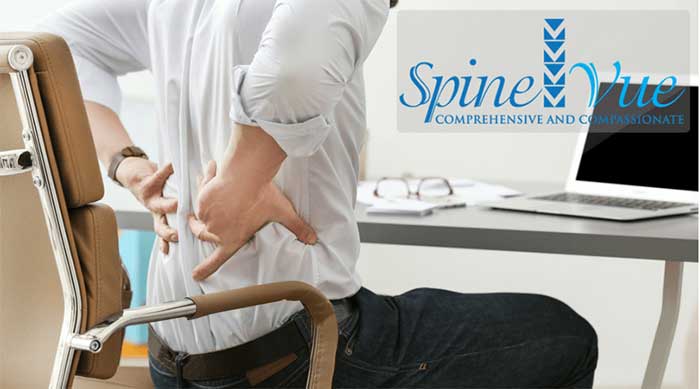Back Pain From Sitting Too Long

Can Sitting Cause Back Pain?
One of the most common complaints that send people to a spine doctor is back pain from sitting too long. Our bodies are of elegant design and are meant for movement. But in today’s world, many of us sit at our desks all day, hacking away at a computer keyboard, our shoulders slumped and our necks hunched at an awkward angle. This leads to multiple issues both in the lower and upper back region which contribute to pain and discomfort in the neck, shoulders, back, and even the legs.
How can prolonged sitting cause back pain? Back problems from sitting stem from the immense pressure that is put on the supporting muscles and discs of the spine. The main portion of the back to experience this pressure is the lumbar disc area. The spine is meant to present a soft “S” curve when viewed from the side. During sitting, it often resembles more of a “C” shape, which can more than double the intradiscal pressure. The results of losing correct posture when sitting are both short and long term and are a recipe for pain that can be difficult to manage.
Back problems from sitting over long periods of time can cause the structure of the lower back to distort, leading to the breakdown of tissues in the muscles and ligaments of the back. Over time, this breakdown leads to trauma, which is the ultimate cause of the pain. Not only does trauma happen to the lower back, but it also affects the cervicothoracic junction. This is the spot where the neck and the shoulders meet; pain between the shoulder blades and neck is indicative of problems in this area.
How to Prevent Back Problems from Sitting
One of the ways to avoid improper posture that leads to chronic lower back pain when sitting down is to make sure your chair and desk are ergonomically designed. Ergonomics is the “practice of designing products, systems, or processes to take proper account of the interaction between them and the people who use them”. Even so, back problems from sitting can occur, so integrate the following into your workday:
- Move and stretch at regular intervals during the day
- Stand up and walk for 2-5 minutes each half-hour
- Place a cushion at the small of your back to help support it
- Make sure your desk and chair are the correct height

Walking and stretching can help keep your joints, ligaments, and tendons loose. Also, as you sit, your discs actually compress, becoming thinner and less “puffy’”. Spinal discs are filled with a gel-like fluid that is meant to separate and cushion them. When these discs flatten due to compression of the spine from sitting too long, pain can occur. This discomfort is often quite severe, leading to a “bone on bone” feeling, degenerative discs, and nerve pain. Ultimately, this state will weaken the back and make you more susceptible to injury from a fall, bending over, or a sudden jolt.
Treatment for Lower Back Pain from Sitting
If you are experiencing lower back pain from sitting and need treatment, options for sitting and recommendations for exercises to strengthen your back and the supporting core muscles, our expert staff at Spine Vue can help! Contact us today to begin living a more pain-free life.
